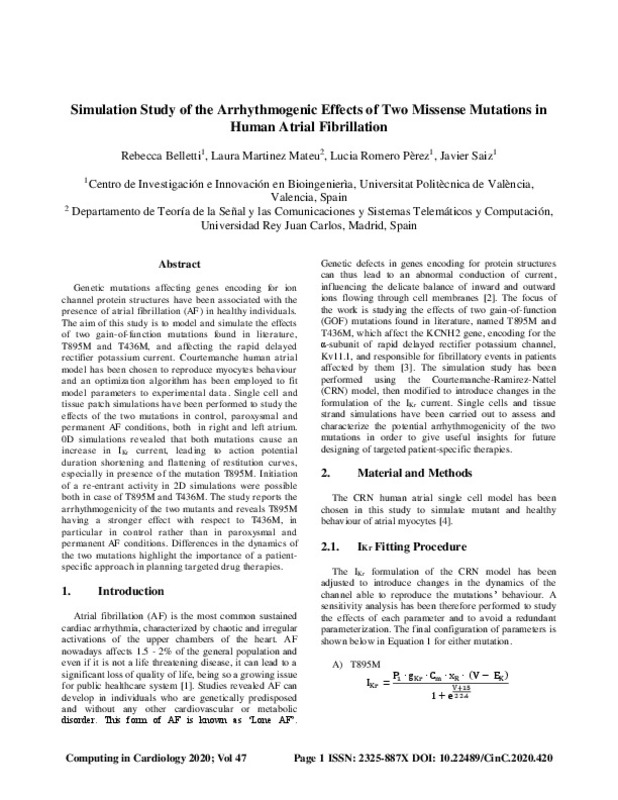JavaScript is disabled for your browser. Some features of this site may not work without it.
Buscar en RiuNet
Listar
Mi cuenta
Estadísticas
Ayuda RiuNet
Admin. UPV
Simulation Study of the Arrhythmogenic Effects of Two Missense Mutations in Human Atrial Fibrillation
Mostrar el registro sencillo del ítem
Ficheros en el ítem
| dc.contributor.author | Belletti, Rebecca
|
es_ES |
| dc.contributor.author | Martínez-Mateu, Laura
|
es_ES |
| dc.contributor.author | Romero Pérez, Lucia
|
es_ES |
| dc.contributor.author | Saiz Rodríguez, Francisco Javier
|
es_ES |
| dc.date.accessioned | 2022-01-18T08:11:44Z | |
| dc.date.available | 2022-01-18T08:11:44Z | |
| dc.date.issued | 2020-09-16 | es_ES |
| dc.identifier.issn | 2325-887X | es_ES |
| dc.identifier.uri | http://hdl.handle.net/10251/179799 | |
| dc.description.abstract | [EN] Genetic mutations affecting genes encoding for ion channel protein structures have been associated with the presence of atrial fibrillation (AF) in healthy individuals. The aim of this study is to model and simulate the effects of two gain-of-function mutations found in literature, T895M and T436M, and affecting the rapid delayed rectifier potassium current. Courtemanche human atrial model has been chosen to reproduce myocytes behaviour and an optimization algorithm has been employed to fit model parameters to experimental data. Single cell and tissue patch simulations have been performed to study the effects of the two mutations in control, paroxysmal and permanent AF conditions, both in right and left atrium. 0D simulations revealed that both mutations cause an increase in IKr current, leading to action potential duration shortening and flattening of restitution curves, especially in presence of the mutation T895M. Initiation of a re-entrant activity in 2D simulations were possible both in case of T895M and T436M. The study reports the arrhythmogenicity of the two mutants and reveals T895M having a stronger effect with respect to T436M, in particular in control rather than in paroxysmal and permanent AF conditions. Differences in the dynamics of the two mutations highlight the importance of a patient-specific approach in planning targeted drug therapies. | es_ES |
| dc.description.sponsorship | I acknowledge this work to the European Union's Horizon 2020 research and innovation programme under the Marie Sklodowska-Curie gran agreement No.766082 and to Generalitat Valenciana, Prometeo programme 2020/043 | es_ES |
| dc.language | Inglés | es_ES |
| dc.publisher | IEEE | es_ES |
| dc.relation.ispartof | CinC 2020: Program. Computing in Cardiology, vol. 47 | es_ES |
| dc.rights | Reconocimiento (by) | es_ES |
| dc.subject.classification | TECNOLOGIA ELECTRONICA | es_ES |
| dc.title | Simulation Study of the Arrhythmogenic Effects of Two Missense Mutations in Human Atrial Fibrillation | es_ES |
| dc.type | Comunicación en congreso | es_ES |
| dc.type | Artículo | es_ES |
| dc.identifier.doi | 10.22489/CinC.2020.420 | es_ES |
| dc.relation.projectID | info:eu-repo/grantAgreement/EC/H2020/766082/EU/ | es_ES |
| dc.relation.projectID | info:eu-repo/grantAgreement/GVA//PROMETEO%2F2020%2F043//MODELOS IN-SILICO MULTI-FISICOS Y MULTI-ESCALA DEL CORAZON PARA EL DESARROLLO DE NUEVOS METODOS DE PREVENCION, DIAGNOSTICO Y TRATAMIENTO EN MEDICINA PERSONALIZADA (HEART IN-SILICO MODELS)/ | es_ES |
| dc.rights.accessRights | Abierto | es_ES |
| dc.contributor.affiliation | Universitat Politècnica de València. Departamento de Ingeniería Electrónica - Departament d'Enginyeria Electrònica | es_ES |
| dc.description.bibliographicCitation | Belletti, R.; Martínez-Mateu, L.; Romero Pérez, L.; Saiz Rodríguez, FJ. (2020). Simulation Study of the Arrhythmogenic Effects of Two Missense Mutations in Human Atrial Fibrillation. IEEE. 1-4. https://doi.org/10.22489/CinC.2020.420 | es_ES |
| dc.description.accrualMethod | S | es_ES |
| dc.relation.conferencename | 47th Computing in Cardiology Conference (CinC 2020) | es_ES |
| dc.relation.conferencedate | Septiembre 13-16,2020 | es_ES |
| dc.relation.conferenceplace | Rimini, Italia | es_ES |
| dc.relation.publisherversion | https://doi.org/10.22489/CinC.2020.420 | es_ES |
| dc.description.upvformatpinicio | 1 | es_ES |
| dc.description.upvformatpfin | 4 | es_ES |
| dc.type.version | info:eu-repo/semantics/publishedVersion | es_ES |
| dc.relation.pasarela | S\429348 | es_ES |
| dc.contributor.funder | Generalitat Valenciana |








